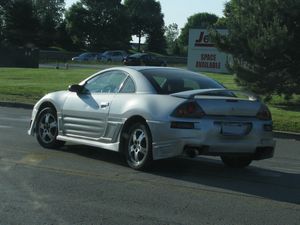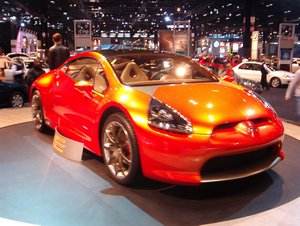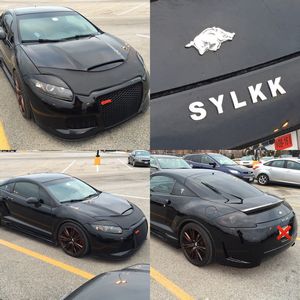















Mitsubishi Eclipse |
|---|
|
| Topic Navigation |
|---|
|
Wikipedia: Mitsubishi Eclipse
Page Sections History Photographs Documents Merchandise Article Index |
History
The following section is an excerpt from Wikipedia's Mitsubishi Eclipse page on 21 November 2017, text available via the Creative Commons Attribution-ShareAlike 3.0 Unported License.
The Mitsubishi Eclipse is a sport compact car that was produced by Mitsubishi between 1989 and 2011. A convertible body style was added during the 1996 model year. The Eclipse was named after an unbeaten 18th-century English racehorse which won 26 races. It was also named after the astronomical event of the same name (as hinted in television commercials in Japan). It has also been rebadged and sold as the Eagle Talon and the Plymouth Laser captive imports through Mitsubishi Motors' close relationship with the Chrysler Corporation. Their partnership was known as Diamond-Star Motors, or DSM, and the vehicle trio through the close of the second-generation line is sometimes referred to by the moniker "DSM" among enthusiast circles. In Japan, the first two generations were sold at a specific Japanese retail chain called Mitsubishi Car Plaza.
The Eclipse was officially marketed in North America, Oman, South Korea, the Philippines, Brazil, Saudi Arabia, Kuwait, UAE, and China. At the end of August 2011, the final Eclipse rolled off the assembly line, and was auctioned off, the proceeds donated to charity. It was not related to the Mitsubishi FTO while having a similar marketing approach.
The Eclipse underwent four generations: the first two generations (1G and 2G) share the automobile platform and parts with the Eagle Talon, and the Plymouth Laser, while the third generation (3G) shared a redesigned platform with the Chrysler Sebring and Dodge Stratus. During May 2005, the fourth, and final, generation (4G) Eclipse was introduced, replacing the Chrysler platform used in the first three generations with the PS platform.
In January 2017, Mitsubishi stated that it plans to resurrect the Eclipse name on a compact crossover vehicle, titled the Eclipse Cross, which debuted at the 2017 Geneva Auto Show in March. The new Eclipse will slot between the Mitsubishi ASX and Mitsubishi Outlander in the Mitsubishi lineup, and is primarily designed to rival the Nissan Qashqai. However, the new Eclipse Cross will be assembled in Japan instead of the United States.
First Generation (1G) (1990–1994)
The first generation Mitsubishi Eclipse was marketed as an entry to mid-level four-cylinder sports coupe. Four trim levels were available; all were front-wheel drive except the GSX which was all-wheel drive. The GS Turbo and GSX were equipped with turbocharged engines.
The first generation Eclipse underwent minor styling changes during its production; 1992–1994 models have updated sheetmetal and are easily distinguishable from earlier model years. The most notable is that the 1990-1991 models have pop-up headlights, whereas the later model years do not. The Eclipse was revised for the 1995 model year as the second generation.
Second Generation (2G) (1995–1999)
The Eclipse was completely redesigned in 1994 (for the 1995 model year) and now came with standard dual air bags, more rounded styling, a larger interior and a new engine made by Chrysler for the base model. The second generation car maintained the market focus of the first generation car but had numerous changes to appeal to a broader market. A convertible model, named the Eclipse Spyder, was introduced in 1996 offered in two trim levels; the GS and the GS-T. The Spyder GS was powered by a 2.4L I-4 naturally aspirated 4G64 engine. The Spyder GS-T was fitted with Mitsubishi's turbocharged 4G63 engine. The GSX model was also powered by this engine but with the addition of a high performance all wheel drive system. No convertible model was powered by the Chrysler's 420a engine, nor was there a convertible with all-wheel-drive.
The turbocharged engine option continued as the 4G63. It was also updated for more power as compared to the previous generation (210 hp vs 195 hp). The naturally aspirated cars had two different I-4 engines depending on the market they were produced for. The US version engines were producing 140 hp, found only in the RS and GS trims, was a modified version of the Chrysler Neon engine, the 420a, manufactured by Chrysler and delivered to and installed at the Diamond Star Motors facility. The European market engines were a naturally aspirated 4G63 with 141 hp (105 kW; 143 PS). International market Eclipses made less horsepower than their Japanese domestic market relatives when equipped with the 4G63 (210 hp, 154 hp), due to emissions regulations at the time.
As the width dimension and larger engines were offered to Japanese consumers, it was now regarded as a luxury car, as this generation no longer complied with Japanese Government dimension regulations, and Japanese consumers were liable for annual taxes as a result, which affected sales.
A special version of the Eclipse, called the "10th Anniversary OZ Rally", was sold at the end of the 1999 model run with unique 16-inch Enkei wheels with the OZ Racing logo. It also included the leather interior package, accented exhaust exit, and hoop-style spoiler that were available as standard equipment on GS-T and GSX models. The special edition package was only offered with the 420A engine.
A unique version of the 2G Eclipse was sold in some European countries. It used a naturally aspirated Mitsubishi 4G63 motor, similar to what was available in the 1G, unique sideview mirrors, and amber rear turn signals.
A minor style revision was applied for the 1997 model year. The front grille opening was given a more aggressive profile. The headlights were given a sharper slant on the inner edges, and the previous all-chrome fixture interior changed to a black interior with chrome reflector inserts. The driving lights were revised from a reflector type to a smaller projection type. The rear bumper cap was altered and had the reverse lights restyled and moved out into the bumper fascia, away from their original central position by the license plate bracket. The GS-T coupe and GSX received a large rear spoiler. The interior color choices also changed from blue, and grey in 1995–1996 model years to black/grey, tan/black, and grey in the 1997–1999 model years. The black leather interior option was only available in 1999; the package included all seats (with the 'Mitsubishi' logo embroidered on both of the fronts), door inserts, and center console armrest.
Third Generation (3G) (2000–2005)
The Eclipse underwent a change into its third generation in 1999, closely applying the Mitsubishi SST design study which debuted at the 1998 North American International Auto Show. It was the first concept vehicle exhibited by Mitsubishi at an auto show in the U.S.
Two new powertrain options were available, a 147 hp 2.4 L 16-valve SOHC 4-cylinder 4G64 and a 205 hp 24v SOHC 3.0 L V6 (6G72). AWD was no longer an option. The suspension setup was adjusted to provide a softer and more compliant ride quality.
The third generation Eclipse shared its powertrain with the 8th generation Galant. In late 2001, power of the GT trim was lowered to 200 hp (150 kW) as a result of tightened emission standards forcing MMNA to adopt the California emissions standards for all variants of the car, rather than selling independent 'Fed Spec' and 'Cali Spec' versions.
In mid-2002, the GTS trim was introduced for the 2003 model year. This vehicle included an engine with a 10:1 compression ratio, revised camshaft profile and an improved Mitsubishi Variable Induction Management (MVIM) air intake system that gave the car an extra 10 hp (7.5 kW) and a slightly improved power curve. The 2003–2005 GTS coupe, GTS Spyder and GT Spyder shared the new engine while the GT coupe retained the 200 hp (150 kW) powertrain.
With the introduction of the 2003 GTS model, the Eclipse saw minor changes including a redesigned front bumper with slotted fog lights, as well as a recoloring of the tail lights. On the interior, the gauge face changed, and the door panels were also redesigned. Newly designed five-spoke chrome wheels were offered with the GT and GTS trims.
Fourth Generation (4G) (2006–2012)
Another substantial styling revision was introduced, with the new model taking some of the profile from the second generation model but maintaining a front fascia consistent with Mitsubishi's current corporate styling features. Drivetrain features of the new model include a 263 hp (196 kW) 3.8 L MIVEC V6 for the GT trim, 2009 and newer models have 265 hp. The GS has a 162 hp (121 kW) 2.4 L MIVEC four-cylinder, both derived from the Mitsubishi PS platform family, with which the Eclipse shares many mechanical components. Like the 2004 Galant and third generation Eclipse, the new Eclipse is FWD only, although a concept model has been produced by Mitsubishi and Ralliart with a MillenWorks designed hybrid-electric AWD platform, the 4G63 engine from the Lancer Evolution, and more aggressive body styling with imitation carbon fiber accents. The V6 produces 263 hp (196 kW) and 260 ft·lbf (350 N·m) of torque.
The fourth-generation Spyder (convertible) Eclipse was released for the 2007 model year at the North American International Auto Show.
| Modified Photo ©2015 Bill Crittenden Green Street Cruise Night: May 18, 2015 View photo of Mitsubishi Eclipse - 3.6MB | |
| Modified Photo ©2015 Bill Crittenden Green Street Cruise Night: May 18, 2015 View photo of Mitsubishi Eclipse - 3.9MB | |
 |
Custom Photo ©2010 Bill Crittenden May 28, 2010 View photo of Custom Mitsubishi Eclipse - 2,047KB |
 |
Photo ©2004 Bill Crittenden 2004 Chicago Auto Show 6 February 2004 View photo of 2004 Mitsubishi Eclipse Concept - 748KB |
 |
Custom with "Sylkk" Badge Note from Bill: I can not find any record of a custom shop with the name "Sylkk," my guess at this point is that the owner bought the letters and used his name for the badge. Photo ©2016 Bill Crittenden View photo of Custom Mitsubishi Eclipse - 3.0MB |
| Date | Document Name & Details | Documents |
|---|---|---|
| February 1998 | Remote Air Bag Related Child Fatality Investigation SCI Technical Summary Report Vehicle - 1998 Mitsubishi Eclipse RS National Highway Traffic Safety Administration | PDF - 208KB - 13 pages |
| April 1998 | Calspan On-Site Air Bag Deployment Investigation Vehicle #1 - 1995 Mitsubishi Eclipse RS National Highway Traffic Safety Administration | PDF - 190KB - 16 pages |
| October 1998 | On-Site Air Bag Investigation Vehicle - 1995 Mitsubishi Eclipse GS National Highway Traffic Safety Administration | PDF - 1,392KB - 19 pages |
| December 1998 | Remote, Redesigned Air Bag Special Study 1998 Mitsubishi Eclipse/1998 Ford Escort National Highway Traffic Safety Administration | PDF - 518KB - 12 pages |
| 10 June 2003 | Safety Compliance Sled Testing for FMVSS 208: Occupant Crash Protection 2003 Mitsubishi Eclipse 2 Door Hatchback National Highway Traffic Safety Administration | PDF - 6.6MB - 149 pages |
| July 2005 | Child Safety Seat Fatality Investigation / Vehicle to Vehicle 1998 Mitsubishi Eclipse National Highway Traffic Safety Administration | PDF - 2,744KB - 23 pages |
| 28 October 2005 | Safety Compliance Testing for FMVSS 214: Side Impact Protection 2006 Mitsubishi Eclipse GS 2-door sport coupe National Highway Traffic Safety Administration | Part 1 PDF - 5.7MB - 115 pages Part 2 PDF - 1.0MB - 117 pages |
| 9 May 2006 | Safety Compliance Testing for FMVSS 201: Occupant Protection in Interior Impact, Upper Interior Head Impact Protection 2006 Mitsubishi Eclipse GS, 2-Door Sport Coupe National Highway Traffic Safety Administration | PDF - 5.2MB - 170 pages |
| 16 June 2006 | Safety Compliance Testing for FMVSS No. 103: Windshield Defrosting and Defogging Systems 2006 Mitsubishi Eclipse, Passenger Car National Highway Traffic Safety Administration | PDF - 1.2MB - 32 pages |
| 16 June 2006 | Safety Compliance Testing for FMVSS 104: Windshield Wiping and Washing Systems 2006 Mitsubishi Eclipse, Passenger Car National Highway Traffic Safety Administration | PDF - 1.3MB - 31 pages |
| 21 July 2006 | Safety Compliance Testing for FMVSS 214S: Side Impact Protection (Static) 2006 Mitsubishi Eclipse, Passenger Car National Highway Traffic Safety Administration | PDF - 2.3MB - 49 pages |
| 28 July 2006 | Safety Compliance Testing for FMVSS No. 111: Rearview Mirrors 2006 Mitsubishi Eclipse, Passenger Car National Highway Traffic Safety Administration | PDF - 1.9MB - 52 pages |
| 13 October 2006 | Safety Compliance Testing for FMVSS 225: Child Restraint Anchorage Systems (Lower and Tether Anchorages) 2006 Mitsubishi Eclipse, Passenger Car National Highway Traffic Safety Administration | PDF - 5.3MB - 83 pages |
| Type & Item # | Name | Details |
|---|---|---|
| Die Cast - Revell 86302600290 | Mitsubishi Eclipse | The Fast and the Furious, 1:64 scale, green w/blue graphics |
| Die Cast - Hot Wheels G6686-0715 G1 (C4982) | Mitsubishi Eclipse Concept Car | 2005 First Editions/Realistix, small scale, orange |
| Die Cast - Hot Wheels L3014-0917N D1 | Mitsubishi Eclipse Concept Car | Code Car, small scale, blue w/flames |
| Date | Article | Author/Source |
|---|---|---|
| 3 April 2004 | Rod Millen Special Vehicles develops hybrid drivetrain for Mitsubishi Eclipse Concept-E | Rod Millen Special Vehicles |
| 26 April 2006 | 2007 Mitsubishi Spyder's Ad Campaign, The | Jennifer Dylan |
| 23 May 2008 | Spyder: A Car that Truly Impresses | Anthony Fontanelle |
| 27 February 2009 | Mitsubishi Eclipse: Something Old, Something New | Ronnie Tanner |
| 27 May 2009 | Evolution of the Eclipse | Ronnie Tanner |
